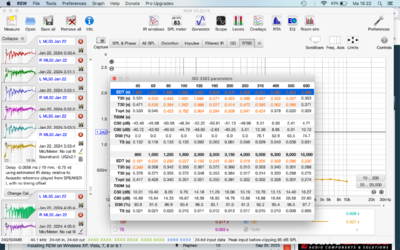Hi
Running REW V5.20.14 64-bit on OS X 10.15.7. When reviewing my measurements, the RT60 tab gives me a nice overview of values of some ISO 3382 parameters in 1/3-octave bands. Very handy. But what does the colour coding mean? Some values are black, some values are orange/red (see attached screenshot). What does their colour mean? Orange = non-valid measurement/calculation? Out of limits? Can't find an explanation in manual or online!
Thanks!
Running REW V5.20.14 64-bit on OS X 10.15.7. When reviewing my measurements, the RT60 tab gives me a nice overview of values of some ISO 3382 parameters in 1/3-octave bands. Very handy. But what does the colour coding mean? Some values are black, some values are orange/red (see attached screenshot). What does their colour mean? Orange = non-valid measurement/calculation? Out of limits? Can't find an explanation in manual or online!
Thanks!













